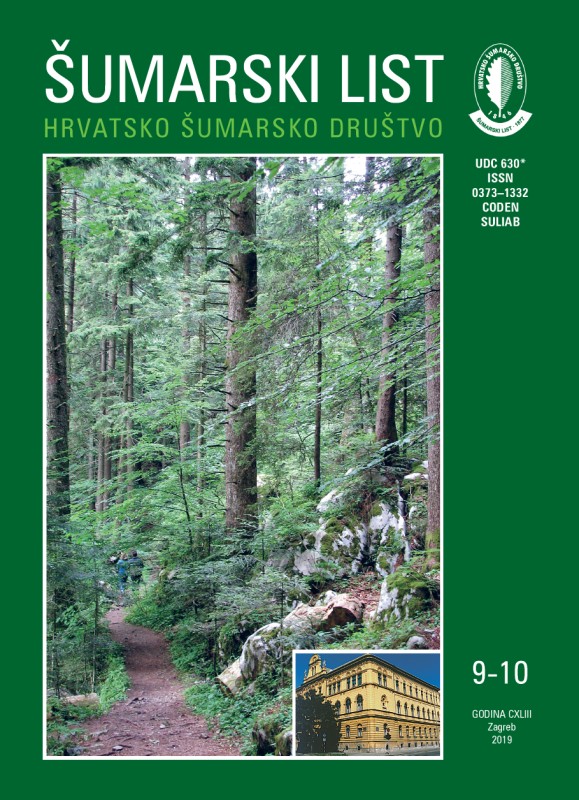
broj: 9-10/2019
pdf (7,03 MB) |
|
||||||||||||||
| RIJEČ UREDNIŠTVA | ||
| Uredništvo | ||
| Will a change in the ministry bring about a changein the attitude towards the forestry profession? pdf HR EN | 389 | |
| IZVORNI ZNANSTVENI ČLANCI | ||
| Damir Ugarković, Željko Španjol, Ivica Tikvić, Dražen Kapučija, Ivana Plišo Vusić | UDK 630* 111 (001) https://doi.org/10.31298/sl.143.9-10.1 | |
| Microclimate differences in the degradation stages of holm oak (Quercus ilex L.) forests pdf HR EN | 391 | |
| Summary Maquis and garrigue are the most common degradation stages of Holm oak forests in Croatia. Disorganized and uncontrolled cutting degrades forests and changes their microclimates. Measurements were conducted in a Holm oak forest in the maquis and garrigue degradation stages, and in an Aleppo pine forest with Holm oak. The highest variations of microclimate elements were measured in the degradation stages of Holm oak. The average air and soil temperatures, precipitation, and potential evapotranspiration were highest in the garrigue stage and lowest in the maquis stage. The average volumetric soil water content was highest in the maquis stage (14.28%) and lowest in the garrigue stage (9.46%). The dry season water deficit was highest in the garrigue stage (-73.95 mm) and lowest in the maquis (-60.38 mm). Microclimate conditions in the garrigue degradation stage are less favorable for the growth and development of Holm oak than in high forest stands. The average values of microclimate elements in the Aleppo pine forest stand with Holm oak were within the average range of the microclimate elements of garrigue and maquis. Key words: Forest microclimate; forest structure; Holm oak; degradation stages; Aleppo pine | ||
| Ivan Lukić, Nikola Lacković, Milan Pernek, Christa Schafellner | UDK 630* 453 (001) https://doi.org/10.31298/sl.143.9-10.2 | |
| Redefinition of critical numbers of gypsy moth (Lymantria dispar L.) egg masses for pedunculate oak (Quercus robur L.) and first calculation for common beech (Fagus sylvatica L.) in Republic of Croatia pdf HR EN | 403 | |
| Muammer Şenyurt, Ilker Ercanli | UDK 630* 524 (001) https://doi.org/10.31298/sl.143.9-10.3 | |
| A comparison of artificial neural network models and regression models to predict tree volumes for crimean black pine trees in Cankiri forests pdf HR EN | 413 | |
| Tomislav Sedlar, Tomislav Sinković, Ivana Perić, Andrej Jarc, Srđan Stojnić, Bogoslav Šefc | UDK 630* 812 (001) https://doi.org/10.31298/sl.143.9-10.4 | |
| Hardness of thermally modified beech wood and hornbeam wood pdf HR EN | 425 | |
| PRETHODNO PRIOPĆENJE | ||
| Anamarija Jazbec, Mislav Vedriš, Ksenija Šegotić | UDK 630*945 https://doi.org/10.31298/sl.143.9-10.5 | |
| Analysing the duration of studyng on undergraduate studies et the Faculty of forestry, University of Zagreb pdf HR EN | 435 | |
| Jelena Nedeljković, Mirjana Stanišić, Dragan Nonić, Mersudin Avdibegović, Marta Curman, Špela Pezdevšek Malovrh | UDK 630* 111 https://doi.org/10.31298/sl.143.9-10.6 | |
| Climate change governance in forestry and nature conservation: institutional framework in selected see countries pdf HR EN | 445 | |
| STRUČNI ČLANCI | ||
| Ivana Plišo Vusić, Irena Šapić, Joso Vukelić | UDK 630* 181.6 + 187 https://doi.org/10.31298/sl.143.9-10.7 | |
| Identification and mapping of Natura 2000 forest habitat types in Croatia (II) – 91F0, riparian mixed forests of Quercus robur, Ulmus laevis, Ulmus minor and Fraxinus angustifolia; 91L0, Oak-hornbeam forests of the illyrian area pdf HR EN | 461 | |
| Damir Drvodelić, Igor Poljak, Ivan Perković, Mario Šango, Katarina Tumpa, Ivana Zegnal, Marilena Idžojtić | UDK 630* 232.3 https://doi.org/10.31298/sl.143.9-10.8 | |
| Laboratory germination testing of the sweet chestnut (Castanea sativa Mill.) according to ISTA rules pdf HR EN | 469 | |


